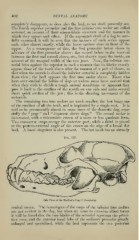Page 392 - My FlipBook
P. 392
402 DENTAL ANATOMY.
completely disappears, as does also the heel, as we shall presently see.
The fourth superior premolar and the first inferior true molar are called
sectorial, on account of their scissor-blade structure and the manner in
which they oppose each other. If the macerated skull of a dog be care-
fully examined, it will be seen that the incisors of each series oppose
each other almost exactly, while the lower canines close in front of the
upper. As a consequence of this, the first premolar below closes in
advance of the first premolar above ; the second below in the interval
between the first and second above, etc., but always upon the inside, on
account of the unequal width of the two jaws. Now, the inferior sec-
torial bites against the superior in such a manner that its blades exactly
oppose those of the tooth above after the manner of a pair of shears, so
that when the mouth is closed the inferior sectorial is completely hidden
from view ; the heel opposes the first true molar above. Those who
have ever studied the habits of dogs or wolves must have noticed that
when they wash to divide a tough animal membrane or ligament they
pass it back to the canthus of the mouth on one side and make several
short quick strokes of the jaw ; this is the shearing movement of the
sectorials.
The remaining two true molars are much smaller, the last being one
of the smallest of all the teeth, and is implanted by a single root. It is
said to be permanently absent in some races of the domestic dog, espe-
cially the " pugs" and "Japanese sleeve dogs." The second molar is
two-rooted, with a tuberculate crown of a more or less quadrate form.
Two transverse cusps occupy the anterior part, while a third is placed
at the postero-external angle of the crown on the edge of a broad flat
heel. A basal cingulum is also present. The last tooth has an obtusely
Fig. 197.
Side View of the Skull of a Dog (C.familiaris).
conical crown. The homologies of the cusps. of the inferior true molars
are not evident in the dog, but when we come to examine allied forms
it will be found that the two blades of the sectorial represent the primi-
tive cone, and the anterior basal lobe of the ordinary premolar greatly
enlarged and specialized, while the heel represents the two posterior


